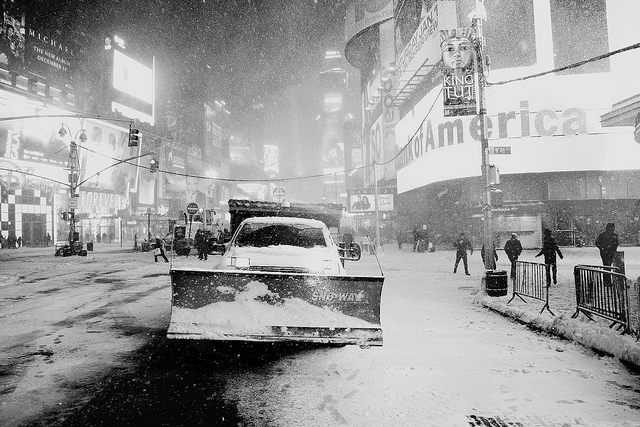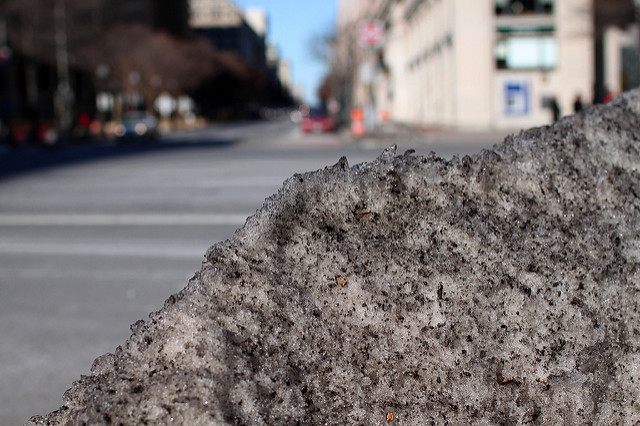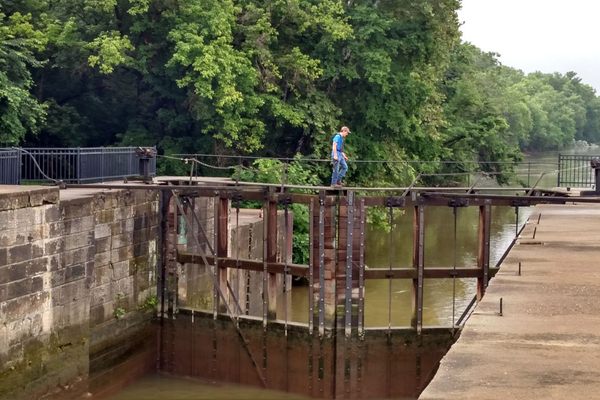The Strange–and Sometimes Secret–Ways Cities Deal With Massive Piles of Snow

Snow in Times Square (Photo: Johan Lange/flickr)
After a big snow storm, snow disposal, even in big cities, used to be relatively simple.
“We used to throw the snow in the water,” says the New York City Department of Sanitation’s Keith Mellis.
But these days, that’s no longer allowed. As snow is plowed from the streets, it rolls up with it all sorts of nasty stuff–normal road dirt, the salt and sand used to keep roads from icing over, and dangerous pollutants including lead, cadmium, coppers and zinc. Turns out, it’s not great for water quality to dump all that into a harbor, river or wetland, however convenient that might be.
Instead, cities make piles of snow.

Snow is actually gross (Photo: Mr.TinDC/flickr)
How do they decide where to make these piles? There are a few criteria that go into these decision. These spots need to publically owned, they need to be empty, and they need to be near enough to sewer infrastructure that can handle a significant volume of water when the snow melts.
In New York, for instance, the city is divided into sectors, and in each one, snow goes into designated areas, owned by the city, including public parking lots, park areas, and streets that are closed off for this purpose. They also have to be close to sewers designated by environmental regulators for quick and voluminous water disposal–not just any random manhole will do. The heads of each sector, Mellis says, are in charge of scouting out these spots and knowing where they are.
New York doesn’t let its snow just sit there, though. For two decades or so, it has used snow melters to speed disposal. As the snow piles build up, the city sends its melters to the piles to deal with the snow. In this past storm, there were 12 out melting snow, but the city has 36 in all (though it’s rare they’ll all be used at once). Before any one snow pile gets too large, the melters are out there, shrinking it down.

Old school snow removal (Photo: Library of Congress)
Melters, though, are an expensive way to get rid of snow and many cities opt to put their snow in one big pile and wait for it to melt. Minneapolis has a snow dump, although its location has been something of a mystery. According to a 2010 story in City Pages, this was the official attitude towards dump sites:
Apparently snow dumps are hard to come by and they don’t want sneaky snow dumpers coming and using their precious space. City officials talk in vague descriptions, calling it “white gold” and refusing to reveal this amazing location.
St. Paul once built a mountain at Midway Stadium that didn’t melt for months. In D.C., after this most recent storm, the city has piled up snow in parking lot of the RFK Memorial Stadium, where some of the snow piles have reached 12 feet high.
As far as snow piles go, though, 12 feet tall is amateur hour. In Anchorage, the city builds snow mountains by creating a level of snow, then icing them down so trucks can climb up the initial level. “We keep ramping up and building up as the winter goes,” the public works superintendent told the Alaska Republic in 2012. That year, the city got so much snow that its private dumps started filling up, and at least one snow pile reached 60 feet. In Boston last winter, the city’s infamous snow pile at one time reached 75 feet and took until July to melt.
It’s June 20th & there’s a snow pile leftover at Minneapolis/St. Paul Int’l Airport! #mnwx pic.twitter.com/ec5fzpgC1j
— EricSorensen (@ERICSORENSEN) June 21, 2014
@jennhsu never forget - https://t.co/y3YYbYPhar
— bergmanj (@bergmanj) January 24, 2016
It is possible to optimize snow piles. “Montreal is, to my mind, one of the real leaders, because their problem is more constant than New York or Washington,” says James Campbell, a professor of management science at the University of Missouri-St. Louis. “They face this every year. They get 80 or 90 inches of snow, and it doesn’t melt. So you have to put it somewhere.”
This was Boston’s ‘snow’ pile last year @brentsbooger. It’s not snow. pic.twitter.com/zyNzncF9w9
— moonlit (@wheeliesmom) January 25, 2016
This is what’s called an “assignment problem,” where you’re trying to assign snow from different parts of the city to particular snow disposal sites. Mathematically, it’s a relatively straightforward issue, says Campbell: You look at the amount of snow that falls, the sites available, and then assign certain neighborhoods to certain sites. But there are other dynamics that can complicate that calculation. Some streets might need to be cleared, because they’re near a hospital, for instance, or for some political reason. In a place where snow is fairly consistent, you wouldn’t have to change the assignments that much, although the place where you’d dispose of snow after the first snowfall might differ from the tenth, as the best sites get filled up.
Other than that, there’s really only one thing to do: hope for warm weather to melt the snow away.









Follow us on Twitter to get the latest on the world's hidden wonders.
Like us on Facebook to get the latest on the world's hidden wonders.
Follow us on Twitter Like us on Facebook